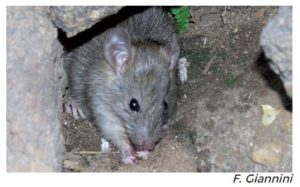Common name:  Black rat
Black rat
Scientific name: Rattus rattus
Brief description: as the name indicates, the colour of this rodent can range from grey-brown to black in the dorsal area, with a whitish belly. The dark tail is normally longer than the body and has small, short and sparse hairs.
Biology and ecology: this is a species that adapts to a variety of environments, even those that are different from one another. It can live both in close contact with man and in more natural habitats and is able to colonise islands of less than a hectare in area, basing its sustenance solely on the very few plant species present. It can live on rocky coastlines but it generally prefers forest environments; it climbs trees easily, in which it builds a spherical nest, similar to that of the common squirrel.
Distribution in the Tuscan Archipelago and introduction: until a few years ago it was present throughout the Tuscan Archipelago and it has only recently been subject to eradication.
Impact: the black rat is considered to be one of the most harmful species against both plant and animal species. It can prey on chicks, eggs of birds nesting on the ground or in the trees, and in many situations it can result in a significant economic impact, as it is able to both damage buildings and feed off fruits and plants of commercial interest. Furthermore, the black rat, since ancient times, has been the carrier of many human diseases, some mortal, such as the plague. R. rattus has been included among the 100 most hazardous alien species in the world by the IUCN. Especially as it is the species against which the most eradication operations have been carried out worldwide.
Management in protected areas: thanks to funding from the European commission, this species has been removed from the islands of Giannutri and Montecristo and the little island of Scola. With the project “Resto con Life” actions for eradication on the Island of Pianosa will also be implemented.




